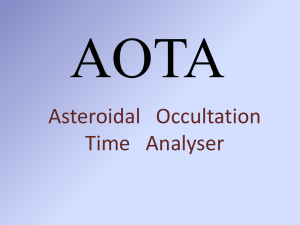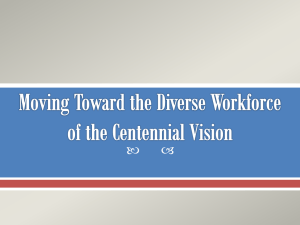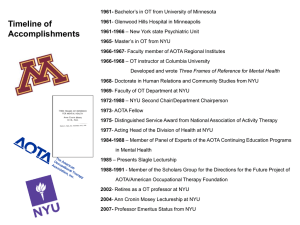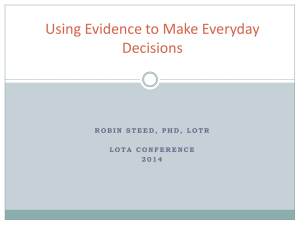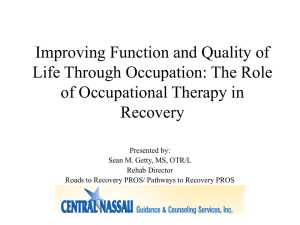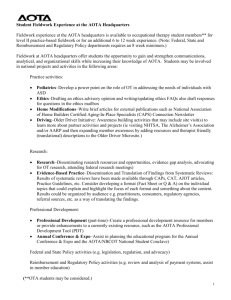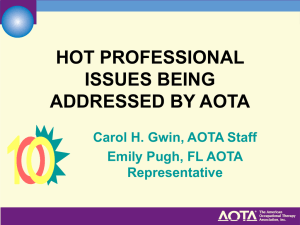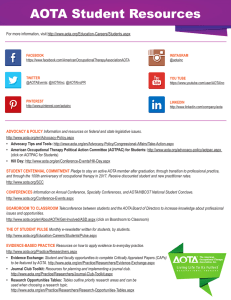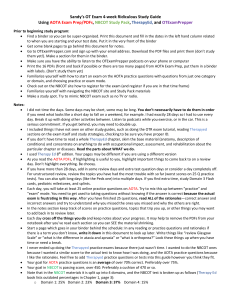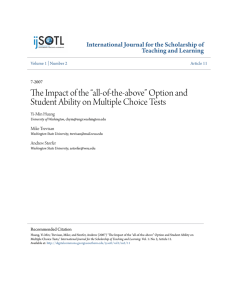(AOTA) Diversity in the Workforce
advertisement
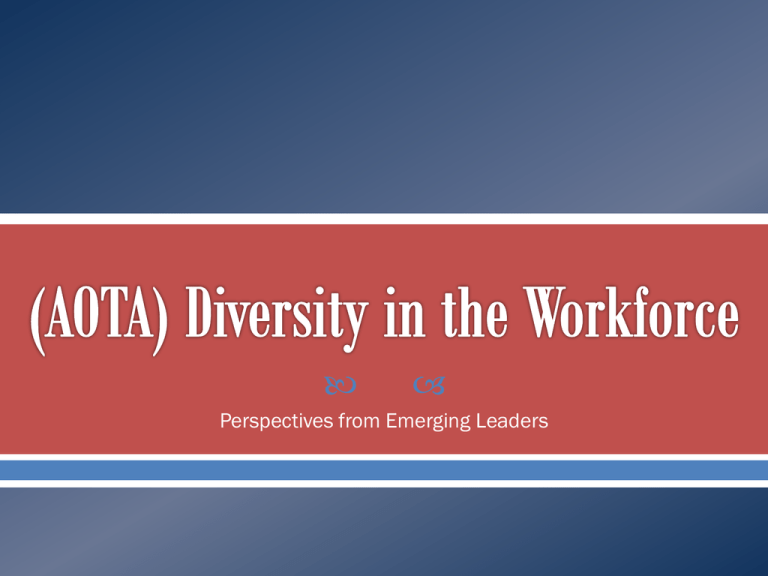
Perspectives from Emerging Leaders Cristina Reyes Smith, OTD, OTR/L o Medical University of South Carolina (Charleston, SC) Arameh Anvarizadeh, OTD, OTR/L o California Children’s Services (Los Angeles, CA) D’Andre Holland, OTD, OTR/L o Every Child Achieves (Los Angeles, CA) Catherine Hoyt Drazen, OTD, OTR/L o Washington University in St. Louis (St. Louis, MO) Nadine Kwebetchou, MS, OTR/L o VA Palo Alto (Palo Alto, CA) Stacy Wilson, MS, OTR/L o WakeMed Health and Hospital (Raleigh, NC) Rationale and Background Focus Group Results and Discussion Personal Perspectives Moving Toward the Diverse Workforce of the Centennial Vision We envision that occupational therapy is a powerful, widely recognized, science-driven, and evidence-based profession with a globally connected and diverse workforce meeting society's occupational needs. (AOTA, 2007) di·ver·si·ty noun \də-ˈvər-sə-tē, dī-\ : the quality or state of having many different forms, types, ideas, etc. : the state of having people who are different races or who have different cultures in a group or organization (Merriam Webster, Inc., n.d.) Age Socioeconomic status Sexual orientation Education Diversity Religion Gender Nationality Race/ Ethnicity Population (2012): 313, 873, 685 o o o o Under 5 years: 6.4% Under 18 years: 23.5% 19 to 64 years: 62.8% 65 and over: 13.7% o Female: 50.8% o o o o o o White, alone: 63.0% Black/African American, alone: 13.1% American Indian/Alaska: 1.2% Asian, alone: 5.1% Two or more races: 2.4% Hispanic/Latino: 16.9% (U.S. Department of Commerce, 2014) (U.S. Department of Commerce, 2014) AOTA Academic Programs Annual Data Report: 2011-2012 (AOTA, 2012) AOTA Faculty Workforce Survey (December 2010) (AOTA, 2010) AIAN=American Indian and Alaska Native; NHPI=Native Hawaiians and Other Pacific Islanders 70 60 50 40 2012 2035 2060 30 20 10 0 White Black AIAN Asian NHPI Two or More Races Hispanic (As cited by U.S. Census Bureau, Population Division in Census.gov, n.d., p. 45) AOTA Academic Programs Annual Data Report: 2011-2012 (AOTA, 2012) AOTA Academic Programs Annual Data Report: 2011-2012 (AOTA, 2012) AOTA Faculty Workforce Survey (December 2010) (AOTA, 2010) B.1.3: Demonstrate knowledge and understanding of the concepts of human behavior... including but not limited to introductory sociology or introductory anthropology. B.1.4: Apply knowledge of the role of the sociocultural, socioeconomic and diversity factors and lifestyle choices in contemporary society to meet the needs of individuals and communities. B.1.5: Demonstrate an understanding of the ethical and practical considerations that affect the health and wellness needs of those who are experiencing or are at risk for social injustice, occupational deprivation and disparity in the receipt of services. B.2.9: Express support for the QOL, well being and occupation of the individual, group or population...considering the context (cultural, personal, temporal, virtual). (AOTA, 2011) B.4.7: Consider factors that might bias assessment results, such as culture, disability status, and situational variables related to the individual and context. B.5.20: Effectively interact through written, oral, and nonverbal communications with the client, family, significant others, communities, colleagues, other health providers and the public. B.5.33: Provide population-based occupational therapy intervention that addresses occupational needs as identified by the community. B.6.3: Integrate current social, economic, political, geographic and demographic factors to promote policy development and the provision of OT services. B.7.9 (OTD only): Demonstrate knowledge of and the ability to write program development plans for provision of services to individuals and populations. (AOTA, 2011) “Occupational therapy practitioners have the responsibility to intervene with individuals and communities to limit the effects of inequities that result in health disparities. Practitioners have knowledge and skills in evaluating and intervening with individuals and groups who face physical, social, emotional, or cultural challenges to participation. Further, the American Occupational Therapy Association (AOTA) supports advocacy to increase access to health services for persons in need, and efforts to lessen or eliminate health disparities are consistent with the Occupational Therapy Code of Ethics and Ethics Standards (2010) (AOTA, 2010).” (AOTA, 2013) Benefits and drawbacks to diversity: o Pros: Increased creativity and innovation o Con: increased conflict through a variety of ideas and beliefs presents o Mediating factors to negative effects of diversity are: 1. Leadership 2. Communication (Dreachslin, Weech-Maldonado, & Dansky, 2004) “Leaders who are able to validate alternative realities and appreciate different perspectives appear to moderate the potential negative effects of racial diversity on team communication processes and strengthen the positive aspects of diversity” (Dreachslin, Hunt, & Sprainer, 2000, p. 1403) “Minorities receiving care in hospitals with a less diverse inpatient population may face greater barriers to health care than those receiving care in hospitals with a more diverse patient population.” (Weech-Maldonado et al., 2012, p. 821) “There is a need for occupational therapy to deepen its understanding of how the experience of being a minority group client within a therapeutic relationship intersects with the process and outcomes of occupational therapy.” (Kirsh, Trentham, & Cole, 2006)

